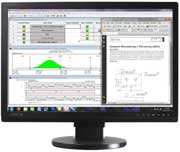Online Monitoring Of Styrene Butadiene Copolymerization, Including A Final Coupling Reaction
by Michael F. Drenski, Wayne F. Reed, Piotr Kozminski, Terry Hogan, Bridgestone Research Americas
The production of SBR via anionic polymerization is commonly used in production. This living type reaction leads to steady chain growth up to a desired molecular weight, at which point a coupling agent is added to link pairs of chains into single chains. The molecular weight of the product is a very important characteristic for determining its performance characteristics, because of its impact on processing and rheological properties.
ACOMP yields continuous data on these important characteristics of the reaction and resulting polymers. These polymer properties include conversion, molecular weight, reduced viscosity and shear thinning viscosity. The principle of ACOMP uses a “front end” to continuously and automatically withdraw a small stream from the reactor and dilute this to any desired degree with a chosen solvent or mix of solvents, while also performing such conditioning steps as phase inversion, filtration, removal of monomer, etc. The result is a continuous stream of dilute, analytical grade polymer solution, similar to what is produced offline in a quality control laboratory. The “detector end” of the ACOMP system continuously receives this diluted, conditioned sample stream and flows it through various desired detectors. In this application, the ACOMP detectors that were used included a multi-wavelength ultraviolet absorption spectrometer (UV), a five-angle static light scattering detector (LS), and low and high shear capillary viscometers. Other detectors are being researched for use in ACOMP, such as IR (infrared), refractometer, polarimeter (for chiral molecule detection), conductivity, dynamic light scattering and Mie scattering.

